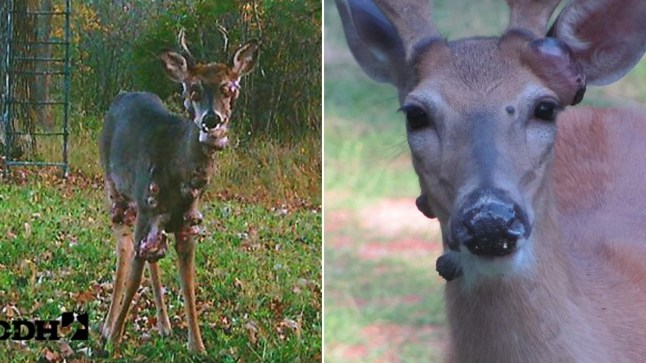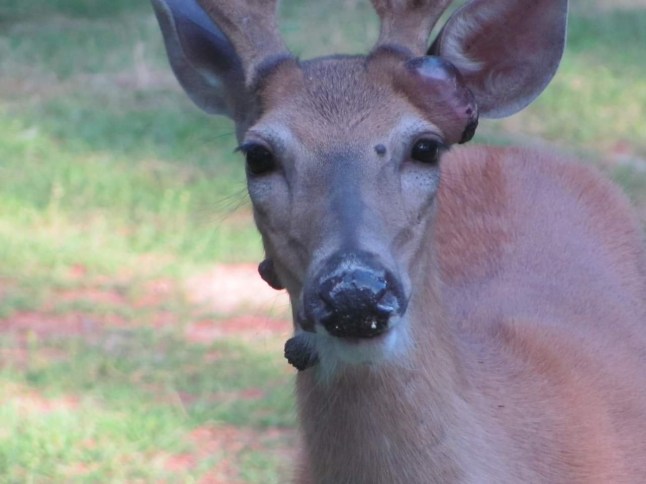
Deer with the growths have been sighted for decades, officials say (Picture: Keri But D&DH/X/@PetnurseSue)
This year has not been too kind to animals in the US.
Americans have spotted so-called ‘Frankenstein’ rabbits oozing sluglike tentacles from their faces and ‘zombie’ squirrels covered in sores in their back yards in recent months.
Now, social media users in New York, Pennsylvania and Wisconsin, among others, say they’re seeing deer covered in fleshy bubbles.
‘A white-tailed deer in Pennsylvania. But what is the growth? Is it a mole? A boil? An injury?’ asked one Reddit user earlier this month.
Clay Moden, a radio show host at WYRK in Buffalo, uploaded trail camera footage of a deer with ‘some sort of growth on it’ in early August.
Don’t go sprinting to your bunker out of fear we’ve got a Last of Us fungal plague on our hands, though.
The deer are infected with deer cutaneous fibroma, a mostly benign infection that can’t spread to other species, including humans.
Better known as deer warts, this strain of fibroma is mainly found in young white-tailed deer and mule deer. It can cause up to two dozen hairless tumours to appear on the animal’s body.
The warts, sometimes as small as a pea to as large as a football, pop up on a deer’s head, neck and forelegs.
These lumps don’t cause the deer any pain, but can hinder their ability to walk, eat or see.
Deer generally overcome the disease on their own within a few months, as the growths slowly dry up and fall off.
One user on X noted last Thursday: ‘…This deer in my yard. [The warts] got worse, then three months later, they were gone.’

A deer covered in warts (Picture: Keri But/D&DH)

The flesh bubbles can be as large as a football (Picture: Matt Harbin/WA Fish & Wildlife)

People have been urged not to touch rabbits infected with a similar virus (Picture: Reddit)
There’s no known cure or treatment and it’s recommended impacted deer be left alone. But if a deer is particularly struggling because of the warty lesions, you should call your local wildlife agency.
Fibroma is transmitted through biting insects, such as mosquitoes, so deer are more likely to contract it in the summer and autumn, when the bugs are most active.
Deer can also be sickened with fibroma by directly contacting a surface where the virus is wriggling on, or by rubbing against an infected deer.
The creatures often trot along the same trails or nibble from the same feeding spots, making transmission possible.
‘Fibromas are more commonly seen in male deer, suggesting that fighting may play a role in transmission of the virus,’ according to the Cornell Wildlife Health Lab.
The Maine Department of Inland Fisheries and Wildlife advises that hunters who harvest an infected deer skin the animal.
The infection caused a scare in 2019, when viral Facebook posts blamed the bulbous deer on a brand of weedkiller, which is not the case.
Many mammals have their own version of deer warts, called papillomas.
Papillomaviruses are behind the recent cases of cottontail rabbits covered in black spikes, which are also spread by mosquitoes and ticks.
This includes humans, too – human papillomavirus (HPV), a common sexually transmitted infection, can cause genital warts.

The harmless growths tend to fall off within a few months (Picture: X/@PetnurseSue)
Dr Omer Awan of the University of Maryland School of Medicine told MailOnline that we might be seeing more ‘gross’ pictures of animals in the future for two reasons.
As humans continue to burn fossil fuels, spewing planet-warming pollution into the air, climate change will make the Earth warmer, helping blood-sucking critters like mosquitoes to thrive.
But another reason for any increases in sightings might not seem as obvious.
‘People are starting to talk about it more, they’re starting to document it more on social media,’ Dr Awan said.
‘Hence, there’s been a lot more discussion about this.’
Get in touch with our news team by emailing us at webnews@metro.co.uk.
For more stories like this, check our news page.
Comments
Arrow
MORE: Toxic vapor kills fifth person in New York City
Arrow
MORE: Map shows Hurricane Erin along US East Coast threatening to isolate barrier islands
Arrow
MORE: Food influencers narrowly escape death after car crashes into restaurant table mid-review
News Updates
Stay on top of the headlines with daily email updates.
